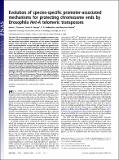Evolution of species-specific promoter-associated mechanisms for protecting chromosome ends by Drosophila Het-A telomeric transposons
Author(s)
Traverse, Karen L.; George, Janet A.; Pardue, Mary-Lou; DeBaryshe, P. G.
DownloadTraverse-2010-Evolution of species.pdf (244.1Kb)
PUBLISHER_POLICY
Publisher Policy
Article is made available in accordance with the publisher's policy and may be subject to US copyright law. Please refer to the publisher's site for terms of use.
Terms of use
Metadata
Show full item recordAbstract
The non-LTR retrotransposons forming Drosophila telomeres constitute a robust mechanism for telomere maintenance, one which has persisted since before separation of the extant Drosophila species. These elements in D. melanogaster differ from nontelomeric retrotransposons in ways that give insight into general telomere biology. Here, we analyze telomere-specific retrotransposons from D. virilis, separated from D. melanogaster by 40 to 60 million years, to evaluate the evolutionary divergence of their telomeric traits. The telomeric retrotransposon HeT-A from D. melanogaster has an unusual promoter near its 3′ terminus that drives not the element in which it resides, but the adjacent downstream element in a head-to-tail array. An obvious benefit of this promoter is that it adds nonessential sequence to the 5′ end of each transcript, which is reverse transcribed and added to the chromosome. Because the 5′ end of each newly transposed element forms the end of the chromosome until another element transposes onto it, this nonessential sequence can buffer erosion of sequence essential for HeT-A. Surprisingly, we have now found that HeT-A in D. virilis has a promoter typical of non-LTR retrotransposons. This promoter adds no buffering sequence; nevertheless, the complete 5′ end of the element persists in telomere arrays, necessitating a more precise processing of the extreme end of the telomere in D. virilis.
Date issued
2010-03Department
Massachusetts Institute of Technology. Department of BiologyJournal
Proceedings of the National Academy of Sciences of the United States of America
Publisher
National Academy of Sciences (U.S.)
Citation
Traverse, Karen L. et al. “Evolution of species-specific promoter-associated mechanisms for protecting chromosome ends by Drosophila Het-A telomeric transposons.” Proceedings of the National Academy of Sciences 107.11 (2010): 5064 -5069. Copyright ©2010 by the National Academy of Sciences
Version: Final published version
ISSN
0027-8424
1091-6490